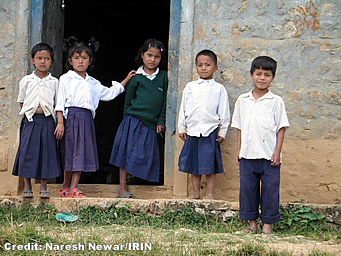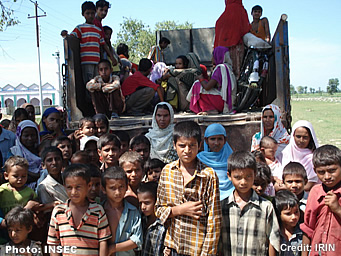
|
 |
| Nepal 2007: Facts on the Conflict |
|
|
|
|
|
|
|
|
| Plight of internally displaced children not improving |
Kathmandu,
11 July 2007 (IRIN)
Despite
the end of Nepal's decade-long conflict between Maoist guerrillas and the
government in November 2006, a large number of internally displaced persons
(IDPs) are still unable to return home, and live in extreme poverty in
urban centres.
 |
|
Among the most serious concerns are that children are unable to get citizenship and birth certificates, are denied free education, suffer food insecurity, and lack social welfare payments.
Getting citizenship "huge problem"
Without a citizenship certificate, IDPs like Puja are deprived of the chance of getting a government scholarship.
All IDPs have to return to their villages to get their citizenship papers, according to the NRC which provides legal assistance to IDPs.
"Getting citizenship is becoming a huge problem for the IDPs as there is little chance younger ones will ever return home to their villages," said Angela Lenn, NRC's project manager for information, counselling and legal assistance.
She said her organisation had been asking the Ministry of Home Affairs and the Ministry of Peace and Reconstruction to help resolve the issue, but it had received no response.
Senior ministry officials told IRIN they were still preparing guidelines for the local government offices so that help could be given to the IDPs.
Vulnerable
Displaced
children are very vulnerable and many are forced to work to support themselves,
according to the National Human Rights Commission (NHRC). Many are now
working as domestics or labourers as they have no alternative, the NHRC
said.
It
seems very unlikely that most of these displaced children will ever return
home as a large number lost their parents during or after the conflict.
top
 |
|
"We have not jeopardised their safety. They can return without fear," Maoist supporter Athak, who is in charge of Banke District in west Nepal, told IRIN.
In Kathmandu alone, there are over 1,000 displaced children living with or without their parents, according to the Maoist Victims Association (MVA), an IDP forum. It believes their number is highest in cities and towns of the far western regions of Nepal - where the conflict's impact was greatest.
"Nothing left"
Six years ago Puja's 45-year-old mother, Rajha, was killed after her house was shelled in the remote Kalikot District - 700km northwest of the capital - during a battle between Maoists and government security forces.
"We have nothing left. I only survive for my children," said her 56-year-old father, Gorkhay, who fled from Kalikot with his family after Maoists tried to recruit his children as soldiers. He is very sick but fears his death would only make his children more vulnerable.
Photo:
Naresh Nawar/IRIN
Many
of the nearly 200,000 displaced people in Nepal live in extreme poverty
in urban centres
Today, his six-member family lives in a tiny room where they share one bed and cook in the same room. The children often get ill due to unhygienic conditions in the house.
Gorkhay has visited local NGOs and aid agencies, political parties and government offices to seek assistance for his children but he always returns empty-handed.
"Living
in this city is much worse for the children. They suffer too much," said
Kusum Raoul of her children. She regretted ever leaving her village in
the remote Humla District nearly 750km northwest of Kathmandu. She and
her six children work in various households and most of the time do not
even get paid.
Copyright © UN Office for the Coordination of Humanitarian Affairs 2007
[ This report does not necessarily reflect the views of the United Nations]
Integrated Regional Information Networks (IRIN), part of the UN Office for the Coordination of Humanitarian Affairs (OCHA).
 |
 |
